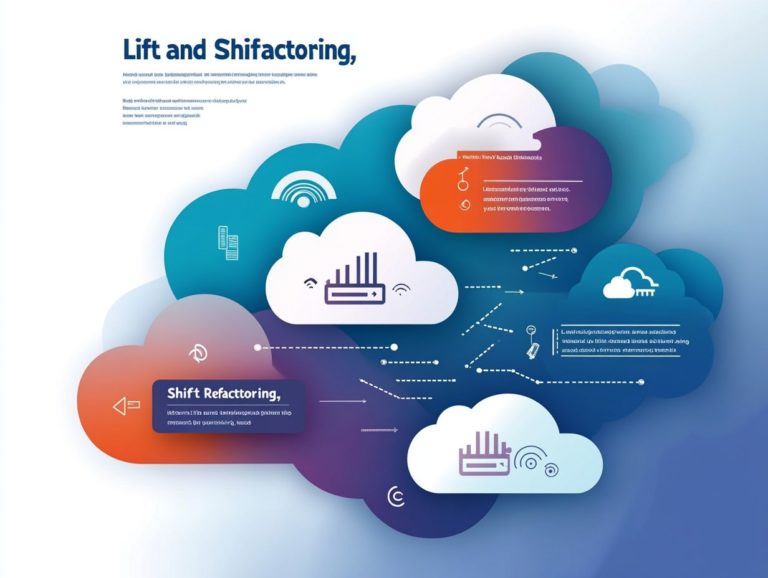Hybrid Cloud vs. Public Cloud: What’s the Difference?
Cloud computing has dramatically changed how you manage data and resources. Discover how this technology can boost your efficiency and flexibility today!
This exploration delves into the nuances of cloud solutions, highlighting the unique features of public and hybrid clouds. By unpacking their definitions and examining the respective benefits and challenges, you are equipped with the essential insights needed to choose the right cloud solution tailored to your requirements.
Regardless of whether you operate a small business or a large enterprise, this guide will supercharge your decision-making process, ensuring you make informed choices that align with your goals.
Contents
- Key Takeaways:
- Understanding Cloud Computing
- Public Cloud vs. Hybrid Cloud
- Benefits of Public Cloud
- Benefits of Hybrid Cloud
- Challenges of Public Cloud
- Challenges of Hybrid Cloud
- Choosing the Right Cloud Solution
- Frequently Asked Questions
- What is the main difference between hybrid and public cloud?
- What are the benefits of using a hybrid cloud over a public cloud?
- Can I use the same applications on both hybrid and public cloud?
- Is data security different in hybrid cloud compared to public cloud?
- Which is more cost-effective, hybrid or public cloud?
- Can I switch from hybrid to public cloud or vice versa?
Key Takeaways:

Hybrid Cloud combines the benefits of both Public and Private Cloud, offering flexibility and security while allowing cost-effective scalability.
Public Cloud is a cost-effective option for businesses with predictable workloads, while Hybrid Cloud is ideal for those with fluctuating needs and sensitive data.
When choosing a cloud solution, consider your business needs and use cases to determine whether Public Cloud or Hybrid Cloud is the best fit for your organization.
Understanding Cloud Computing
Cloud computing is a game-changing technology that allows you to access computing services over the internet. It empowers your organization to tap into various cloud models public, private, and hybrid each designed to meet distinct business needs and offering unique advantages.
By partnering with cloud providers like Amazon Web Services, Microsoft Azure, and Google Cloud Platform, you can enhance data security, achieve scalability, and enjoy cost savings, all while sidestepping the hassles of traditional IT infrastructures.
Public Cloud vs. Hybrid Cloud
Understanding the differences between public and hybrid cloud solutions is essential. This knowledge helps organizations make informed decisions about their cloud infrastructure.
Each model offers unique features and benefits tailored to specific operational needs and data security requirements.
Public cloud services, provided by industry giants such as Amazon Web Services, Microsoft Azure, and Google Cloud Platform, deliver scalable resources accessible via the internet.
In contrast, the hybrid cloud integrates both public and private cloud functionalities, granting you enhanced flexibility and control over sensitive data.
Basic Differences and Similarities
When you compare public cloud and hybrid cloud, it s crucial to understand both their differences and similarities, especially regarding service downtime, network latency, and compliance issues that can influence your choice of cloud model.
Public clouds usually have lower upfront costs thanks to their shared infrastructure, making them a tempting option for startups and small businesses eager to keep expenses in check.
However, this advantage often comes with a trade-off in control and customization; you ll find that your influence over the underlying hardware and software configurations is quite limited.
On the other hand, hybrid clouds grant you greater flexibility by allowing you to tailor resources to fit your specific needs, which can significantly boost operational efficiency.
Despite these distinctions, both models shine in scalability and on-demand computing. They give you the power to swiftly adjust resources according to your immediate requirements, ultimately optimizing workload management and enhancing cost efficiency.
Benefits of Public Cloud
The public cloud model presents a wealth of advantages, such as substantial cost savings and unmatched scalability, making it an enticing choice for businesses of any size.
By utilizing the infrastructure offered by top-tier cloud providers like Amazon Web Services, Microsoft Azure, and Google Cloud Platform, you gain access to an array of services and automatic software updates.
This gives your organization the power to concentrate on your core operations, freeing you from the complexities of managing physical hardware.
Cost-effectiveness and Scalability

Cost-effectiveness and scalability are compelling reasons to choose the public cloud. It allows you to allocate resources efficiently based on real-time demands, ensuring you pay only for what you actually use.
Embracing public cloud solutions can significantly cut down on capital expenditure. This approach frees you from the heavy burden of upfront investments in hardware and infrastructure.
This model gives you the power to direct funds toward innovation and growth instead of getting bogged down by maintenance costs. With flexible pricing structures, you can tailor your expenses to fit your specific needs, ensuring you aren t overpaying for resources you don t utilize.
As your demands fluctuate, the inherent scalability of cloud services enables you to swiftly adjust your resource allocation. This means ramping up during peak seasons or scaling down in slower periods, ultimately preserving your operational efficiency.
Benefits of Hybrid Cloud
Many enterprises are choosing the hybrid cloud model, and it s clear it offers exciting opportunities. It provides remarkable flexibility and heightened security, allowing you to customize your cloud strategy to fit your unique operational needs while safeguarding your data.
By harnessing the strengths of both public and private cloud services, you can optimize resource management and adhere to stringent regulations. This makes hybrid cloud solutions not just viable but an intelligent choice for many organizations looking to elevate their capabilities.
Flexibility and Security
Flexibility and security define the hybrid cloud model. It allows you to keep sensitive data in private clouds while reaping the benefits of scalability and affordability provided by public cloud services.
This dual approach gives you the power to strategically choose data storage solutions that align perfectly with your specific compliance, performance, and budgetary needs.
By leveraging the expertise of top-tier cloud providers, you can seamlessly integrate public and private resources. This ensures that your sensitive information is protected through advanced encryption, a method of protecting data by converting it into a coded format, and stringent access controls.
Cloud providers equip you with robust monitoring tools that deliver real-time insights and automated security updates, further enhancing your data protection measures.
In this manner, the hybrid cloud model maximizes your operational efficiency while strengthening your security posture in an ever-evolving digital landscape.
Challenges of Public Cloud
While the public cloud model offers many advantages, it’s essential to recognize the potential risks and challenges that come with it. You may encounter issues such as service downtime, network latency, and data breach concerns.
These challenges can slow down your operations, necessitating careful planning and management. Address these challenges wisely to unlock the full potential of public cloud services from providers like Amazon Web Services and Microsoft Azure.
Potential Risks and Limitations
The potential risks and limitations of the public cloud primarily hinge on cybersecurity threats, data breaches, and various compliance issues that you must address to protect your sensitive information.
In today s digital landscape, the odds of encountering data breaches have surged, leaving organizations like yours vulnerable to severe reputational and financial consequences. Navigating stringent compliance standards, such as GDPR or PCI DSS, can pose significant challenges, especially since these regulations demand a robust framework for data protection and user privacy.
These obstacles encourage you to adopt best practices for risk mitigation. Implement strong encryption protocols, conduct frequent security audits, and provide comprehensive employee training.
By fostering a culture of awareness and employing advanced security measures, you can effectively navigate the complexities of public cloud environments and enhance your overall security posture.
Explore cloud solutions today to elevate your organization s capabilities!
Challenges of Hybrid Cloud

While the hybrid cloud model offers many advantages, it also brings complexities and integration challenges that must be addressed.
These issues often arise in resource management and the interoperability between public and private systems. If not managed effectively, these challenges can hinder performance. Engaging in thorough planning and execution is essential to achieve seamless operations across your cloud environments.
Complexity and Integration Issues
Complexity and integration issues pose significant challenges when implementing hybrid cloud solutions. Your organization must ensure that the cloud infrastructure operates cohesively across both public and private environments.
Navigating data transfer between these diverse systems can be puzzling. You might encounter hurdles related to latency, bandwidth, and secure handling of sensitive information.
Ensuring compatibility across platforms is crucial, often requiring careful selection of integration tools and protocols. Use middleware solutions to ease these challenges and facilitate communication between your cloud environments.
Adopting a microservices architecture can enhance compatibility and scalability, giving you greater flexibility in application deployment and management.
Choosing the Right Cloud Solution
Choosing the right cloud solution is crucial for your organization! It necessitates examining various factors and optimal use cases that align with your unique operational needs be it public cloud, hybrid cloud, or private cloud services.
By understanding the specific advantages and challenges associated with each model, you can make informed decisions that elevate your cloud strategy and pave the way for long-term success.
Factors to Consider and Best Use Cases
When evaluating cloud solutions, consider factors such as data security, compliance issues, and specific business use cases that will determine whether a hybrid cloud, public cloud, or private cloud service model best fits your needs.
Moreover, budget constraints significantly shape your decision-making process. Public cloud options may be attractive due to their low initial investment and pay-as-you-go model, offering flexibility without upfront costs.
If you re part of a larger enterprise with substantial scalability requirements, a hybrid cloud solution may be your best bet! This allows you to integrate existing on-premises resources with cloud capabilities.
Aligning your choice with organizational goals, such as enhancing innovation or improving customer service, will further clarify the right direction.
For instance, sectors like healthcare might prioritize private clouds to ensure stringent data protection and compliance with regulations like HIPAA. In contrast, e-commerce businesses could thrive with dynamic public cloud services to handle peak traffic during sales events.
Frequently Asked Questions
What is the main difference between hybrid and public cloud?

Hybrid clouds give you more control and customization than public clouds. A hybrid cloud combines both private and public cloud features, allowing for better data placement and security. Public cloud, on the other hand, is owned and managed by a third party with limited customization options.
What are the benefits of using a hybrid cloud over a public cloud?
Hybrid cloud offers the benefits of both public and private clouds, including cost-effectiveness, scalability, and flexibility. It also allows organizations to keep sensitive data on the private cloud while using the public cloud for non-sensitive data.
Can I use the same applications on both hybrid and public cloud?
Yes, you can use the same applications on both hybrid and public clouds. However, some applications may need customization to work seamlessly in a hybrid cloud environment.
Is data security different in hybrid cloud compared to public cloud?
Yes, data security differs between hybrid and public clouds. In a hybrid cloud, organizations have better control of their data security.
They can choose where and how to store sensitive information. In a public cloud, a third-party provider handles data security responsibilities.
Which is more cost-effective, hybrid or public cloud?
The cost-effectiveness of hybrid versus public cloud depends on your organization’s needs. Hybrid cloud often saves money for those with changing data storage needs, while public cloud suits those with steady demands.
Can I switch from hybrid to public cloud or vice versa?
You can switch between hybrid and public clouds. This process requires effort to transfer data and applications, so planning is crucial.
Strategize carefully to avoid disruptions to your business operations. A successful transition can significantly benefit your organization!






